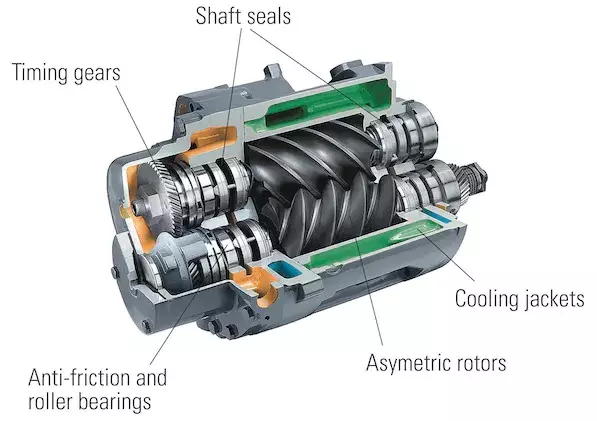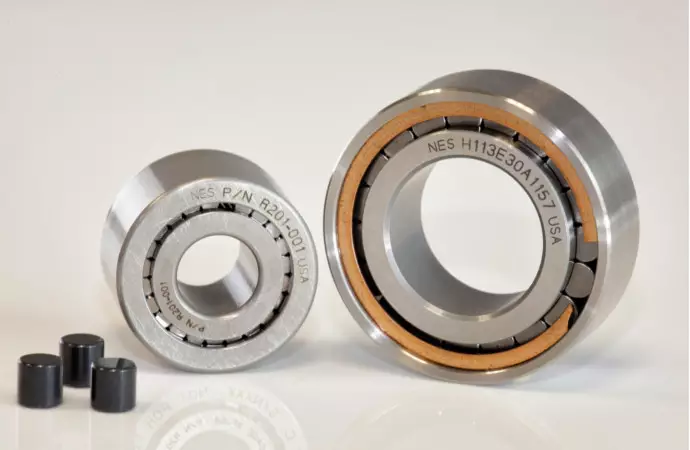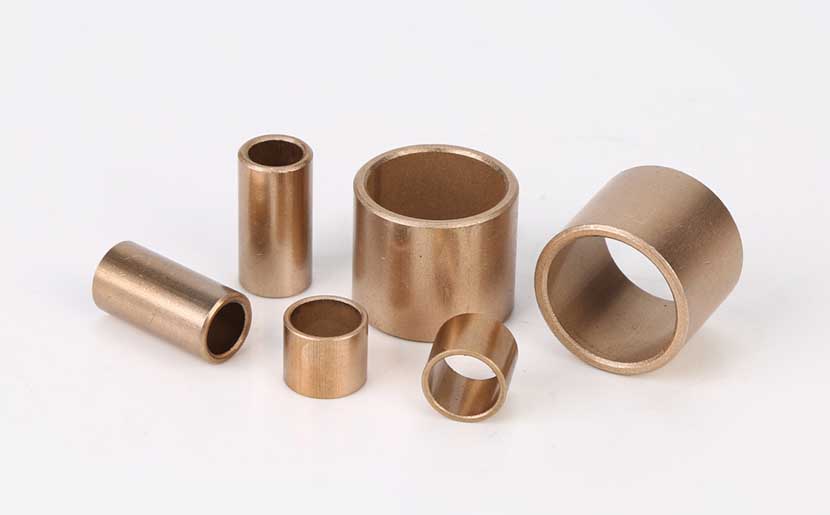
Complete Overview of Pump Bearing Types
Most fluids moving through a system require the utilization of a pump or compressor. Pumps are generally designed to move liquids or gasses. Compressors normally move gas due to its natural ability to be compressed. Pumps and compressors both have very high pressure rises. Both Pumps and compressors use bearings.
Pumps and compressors use common sizes and types of mechanical bearings . There are two basic types of pumps which are either classified as positive displacement pumps or centrifugal pumps. This article will cover the various bearing types applied in these pumps for use in most general applications.

The pump bearings we will discuss in this article are mechanical components designed to support the rotating shaft of a pump. They facilitate smooth rotation while withstanding the axial and radial loads. The primary function of pump bearings is to reduce friction between the rotating shaft and stationary parts, which ultimately improves the pump’s efficiency and lifespan.
These bearings are typically located close to the impeller and are subjected to a variety of forces, including axial thrust, radial loads, and moments. As a result, pump bearings need to be robust, reliable, and capable of withstanding demanding operating conditions.
Types of Pump Bearings
There are several types of pump bearings, each suited to specific applications and operating conditions. The most common types are as follows:
- Thrust Bearings
Thrust bearings are designed to endure axial loads, ensuring the axial stability of the pump shaft during operation. Various designs of thrust bearings are available to cater to different application needs. Ball thrust bearings and roller thrust bearings incorporate rolling elements to bear axial loads efficiently, while fluid-film thrust bearings utilize a thin lubricating film to generate a hydrodynamic wedge, providing high load-carrying capacity and minimal friction. The choice of thrust bearing type depends on factors such as load capacity, rotational speed, and the type of fluid being pumped.
- Rolling Element Bearings
Rolling element bearings are widely prevalent in pump applications due to their versatility in supporting both radial and axial loads. These bearings utilize rolling elements, such as balls or rollers, to reduce friction and enhance the efficiency of the pump. They are available in various configurations, including deep groove ball bearings, cylindrical roller bearings, and angular contact ball bearings. Engineers select the appropriate rolling element bearing based on the pump’s design, load requirements, and operating conditions.
Buy cylindrical Roller bearings for pumps online from Pacific International Bearing Sales Inc.

- Ceramic Bearings
Ceramic bearings, composed of silicon nitride or zirconia, offer exceptional hardness and wear resistance. The rolling elements’ low coefficient of friction minimizes energy losses and heat generation, making ceramic bearings ideal for high-speed pumps. Ceramic bearings have characteristics which steel bearings do not have.

Ceramic bearings are non-magnetic. Ceramic bearings are heat resistant, have a longer service life, and can be divided into full ceramic bearings and hybrid ceramic Bearings. The components of full ceramic bearings are entirely made of ceramic.
Hybrid ceramic bearings have steel races and ceramic rolling elements. The outer and inner ring of the hybrid ceramic bearing is made from special steel, including high carbon chromium bearing steel or stainless steel.
The various cages are made of metallic material, resin or composite material depending on the intended operating conditions of the bearing.
- Hybrid Bearings
The use of hybrid bearings combining ceramic rolling elements with steel bearing rings is used frequently in pump applications. The hybrid design capitalizes on the strengths of both materials, resulting in enhanced performance in demanding pump applications.
The permissible operating temperature for hybrid bearings may be limited by the dimensional stability of the bearing rings, the cage, the seals and the lubrication. Generally inner and outer rings of quality hybrid bearings are heat stabilized. For example, SKF can supply hybrid bearings with rings stabilized for operating temperatures up to 300 °C (570 °F). A quality manufacturer should stabilize rings to the following temperatures:
- 120 °C (250 °F) for basic design hybrid deep groove ball bearings
- 150 °C (300 °F) for hybrid cylindrical roller bearings and XL hybrid deep groove ball bearings
Cages for Hybrid bearings are steel, brass or peek. The cages can be used at the same operating temperatures as the bearing rings of standard hybrid bearings. The permissible operating temperature for seals depends on the seal material:
- NBR: –40 to +100 °C (–40 to +210 °F)
- Temperatures up to 120 °C (250 °F) can be tolerated for brief periods
- FKM: –30 to +200 °C (–20 to +390 °F)
- Temperatures up to 230 °C (445 °F) can be tolerated for brief periods
Typically, temperature peaks are at the seal lip
- Magnetic Bearings
Magnetic bearings have gained popularity due to their non-contact operation, minimizing friction, and wear. They use active control systems to maintain precise shaft positioning, enabling high-speed operation and reduced energy consumption. Watch the SKF video to learn more about magnetic bearings and systems.
- Fluid-Film Bearings
Fluid-film bearings, also known as hydrodynamic bearings, operate by creating a thin film of lubricating fluid between the rotating shaft and the bearing surface. This design generates a hydrodynamic wedge, effectively separating the two surfaces and eliminating direct metal-to-metal contact. Fluid-film bearings provide excellent load-carrying capacity, low friction, and reduced wear, making them ideal for large industrial pumps and high-speed applications.
- Smart Bearings
Smart or sensor bearings, equipped with sensors and monitoring systems have revolutionized maintenance practices. They continuously collect data on temperature, vibration, and load distribution, providing real-time insights into bearing health.

One such crucial formula for predictive maintenance is the vibration severity formula.
Select and buy SKF sensor unit bearings from Pacific International Bearing
Pumps for the Oil & Gas Industry
In the oil and gas industry, offshore production presents a unique set of challenges for pump operations due to harsh environmental conditions, including exposure to corrosive seawater, extreme temperatures, and high mechanical loads. To ensure reliable and efficient pumping in these critical applications, engineers have turned to advanced bearing technologies, such as ceramic bearings mentioned earlier in this article.
- Ceramic Bearings in Offshore Oil and Gas Pumps
Ceramic bearings, with their exceptional material properties, have revolutionized the performance of pumps in offshore oil and gas platforms. These bearings, typically made from silicon nitride or zirconia, exhibit superior hardness, wear resistance, and corrosion resistance compared to traditional steel bearings. This enhanced durability is of paramount importance in environments where pumps are subjected to aggressive chemical agents and abrasive particles present in seawater.
Improved Pump Reliability
The adoption of ceramic bearings in offshore pumps has significantly improved pump reliability. Their resistance to wear and corrosion translates into reduced bearing failures and increased pump uptime, minimizing costly downtime associated with maintenance and replacements. The enhanced longevity of ceramic bearings under harsh conditions contributes to increased operational efficiency and cost savings for oil and gas producers.
What Are Some Common Applications for These Bearing Types?
Bearing types in pumps for the oil and gas industry serve several common applications. Primarily, they are used to support the rotor, handle axial and radial loads, and maintain the position of the rotor within the pump’s casing. This ensures smooth and efficient operation, reducing vibrations and minimizing wear and tear. Additionally, bearings in these pumps help in dealing with the high-pressure environments typical in oil and gas operations, ensuring reliability and durability under challenging conditions.
Other Bearing types used in pumps for the oil and gas industry
- Single Row Deep Groove Pump Bearings
The deep groove geometry allows them to accommodate radial loads as well as moderate axial loads in both directions. The deep groove design also helps in effectively sealing the bearing, protecting it from contamination and extending its service life. These bearings are particularly useful in applications where space is limited but high load capacity is required.
- Double Row Angular Contact Pump Bearings
Bearings feature two rows of rolling elements which allow them to accommodate higher axial loads in both directions compared to single row designs. The contact angle of these bearings is typically optimized for the specific application, enhancing their ability to support axial loads. This design makes them ideal for use in pump applications where there are high axial loads, such as in high-pressure pumps.
- Single Row Angular Contact Bearings
These bearings are typically used in applications where the load carrying capacity needs to be oriented in a specific direction. In pump applications, they are often used in configurations where a pair of bearings supports axial loads in opposite directions, providing balance and stability to the pump system.
Oil and gas applications include irrigation pumps,vacuum pumps, extraction pumps, compressors, and turboexpanders, high flow pumps, industrial compressors and oxygen compressors.
Pump Bearings in Power Generation Industry
Power generation plants rely on large pumps to circulate cooling water and generate electricity. Hybrid bearings have proved effective in mitigating wear and extending pump service life in such high-load conditions.
Large pumps in power plants are responsible for circulating cooling water, managing condensate systems, and supporting other vital processes. The success of these operations relies on the reliability and longevity of pump bearings, especially under high-load conditions.
SKF magnetic bearings and high-speed electric generators merge technologies to create efficient power generation equipment.

Power generation applications
SKF magnetic bearings working in a compact 9 MW power station gas turbine and generator.
Pressure let-down
Pressure let-down applications are a popular technology creating electricity due to an increase in both cost and need for electricity. As there is a need to lower the pressure in gas pipelines. SKF developed efficient and robust generators for this purpose.
Hybrid Bearings for Large Power Generation Pumps
Power generation pumps often encounter substantial mechanical loads and varying operating conditions, demanding bearings that can withstand these challenges. Hybrid bearings, combining ceramic rolling elements with steel bearing rings, have emerged as a suitable solution for high-load power generation applications.

Mitigating Wear and Extending Service Life
Hybrid bearings are designed to manage heavy radial and axial loads while maintaining low friction and operational stability. This capability significantly mitigates wear and reduces the likelihood of premature bearing failure, extending the service life of power generation pumps.
Enhanced Efficiency and Energy Savings
By reducing friction losses and ensuring smooth operation, hybrid bearings contribute to improved pump efficiency and energy savings in power generation plants. The reduced energy consumption translates into financial savings and lower carbon footprints, making power plants more sustainable and environmentally friendly.
Conclusion
Advancements in pump hybrid and magnetic bearing technology have transformed the pump industry, enhancing performance, reliability, and efficiency. The integration of ceramic, hybrid, and magnetic bearings, coupled with smart bearing technology, has significantly improved pump reliability and reduced maintenance costs in various industries.
Still have a question or need to discuss something? Contact us to get help.


